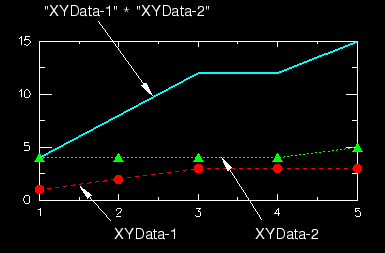Context:
Figure 1 shows an X–Y plot of the preceding example.
Figure 1. X–Y plot illustrating multiplication of data objects.

Locate the Operate on XY Data dialog box.
From the main menu bar, select . Click Operate on XY data in the dialog box that appears; then click Continue. The Operate on XY Data dialog box appears.
From the XY Data choices, click the name of the X–Y data object on which to operate and click Add to Expression. You can choose from all X–Y data objects previously saved within this session (listed alphabetically in the XY Data field).
The X–Y data object name appears within the expression window.
From the Operators listed, click .
The symbol appears after the data object name in the expression window.
To specify the second argument, do one of the following:
-
Use your mouse and keyboard to enter a scalar as the second argument of the operator in the expression window, or
-
From the XY Data choices, click the name of a data object argument for the operator in the expression window and click Add to Expression.
To continue to build your expression, position the cursor in the expression window and type in or select the functions, operators, and X–Y data you want to include.
To evaluate and display your expression, click Plot Expression.
To save your new X–Y data object, click Save As and then provide a name in the dialog box that appears.
Saving your data object makes it available for future operations within this session and for inclusion in X–Y plots containing multiple data objects.
When you are finished, click Cancel to close the dialog box.

